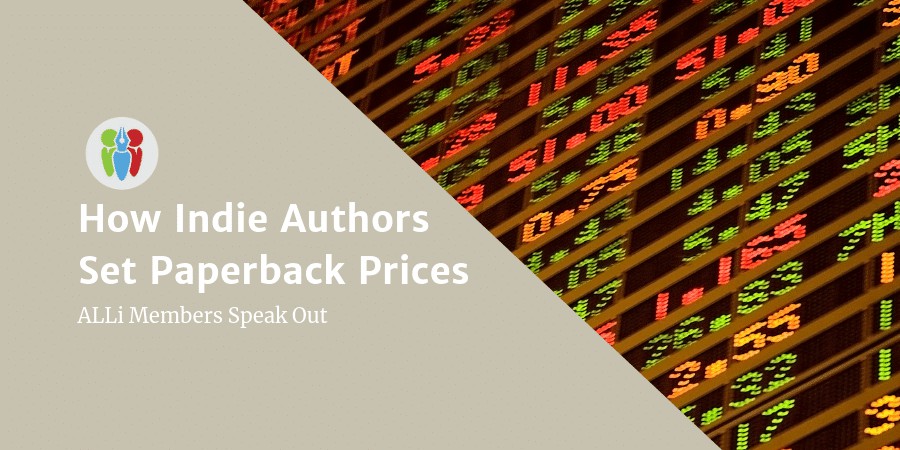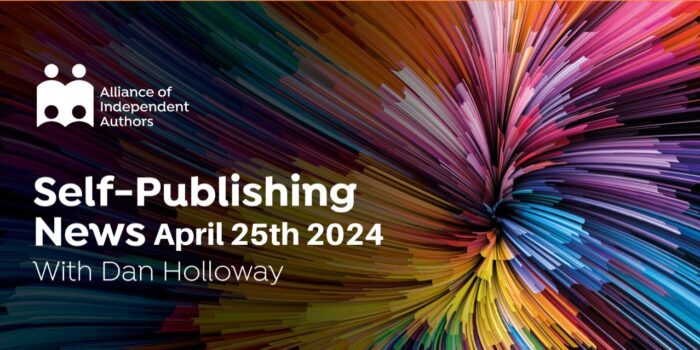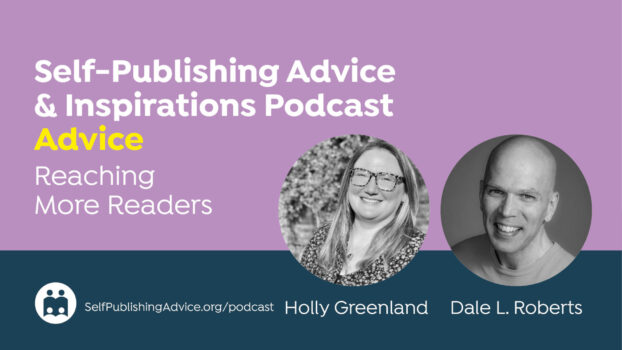Recently on the private ALLi Member Facebook Forum there've been a couple of active comment threads with questions about how indie authors set paperback prices. Here's a compilation of the responses so you can see for yourself what some of the options are for pricing your own books.
How do I set paperback prices for my books? Is there a magic formula? This question, or a version of it, was posed by two different author members recently. Of course how one indie author answers that question might differ from another. Do you set it based on what profit margin you want? What other books in the genre are selling? Do you close your eyes and blindly choose a random price?
Here are some of the answers we heard from authors on the ALLi FB forum.
How Indie Authors Set Paperback Prices
John Doppler: It depends on the genre. KDP offers a pricing tool that's been in beta for several years, but it can give you a suggestion about where to begin. Look for the button on the pricing tab of your book's setup.
Kelley Miller: IngramSpark has a print book price calculator based on where I want to sell my print books. Their calculator tells me what my profit will be for print-on-demand books. It's not much. Yet, I don't want to overcharge readers since I'm new to self-publishing. I'm also selling my ebooks and print books on Amazon. They have a calculator too.
Consider Royalties and Costs
Karl Drinkwater: “It depends on the printing costs (which are in turn dependent on trim size and page count), as well as other issues such as genre. However, the approach I take is to decide how much royalty I would want, then choose the minimum print list price that will give me that royalty (rounded to the nearest $0.50 or 0.99).
Debbie Young: I think what royalty I want is irrelevant. I put myself in the reader's shoes and ask what price I would pay for that book. It will only sell at a price people are prepared to pay, and I'd rather shift a lot of copies and get lower royalties per sale than sell fewer at my ideal royalty. I'd never price a book above what similar books by authors of similar status are charging. Never more than a famous author would get for a similar book.
Oliver Tooley: For novels, £6-£10 depending on length. It also needs to be at least double the unit printing cost. Usually more like three times or what's the point? A few examples, my fantasy series is priced at £7.99 (55k words). Cost to print 400 copies worked out around £2 per book and there were all the production costs as well. A more recent book by another author is priced at £8.99 (80k words) and we did a print run of 1,000 and the unit cost was IRO £1.80. Obviously the PoD (print on demand) cost is much higher. Also, my rule of thumb for Kindle editions is 50 percent of the print price.
Compare Prices of Other Books
Lk Hunsaker: I look at trad books [sic] of the same or similar genre and try to stay as close to that as possible. While doing so, I make sure I can give local places willing to carry my books a 40 percent commission and still make something myself. Often, they make more than I do, but I'd rather have a lower profit sale than no sale.
Kevin Partner: I set it high and then test it. I charge more for nonfiction. Bear in mind that a book choosing £10 is shipped for free in the UK, so it's worth testing whether a tenner converts better than £9.99. It works for me. What are your competitors charging? As indies we have complete flexibility to change our pricing whenever we want.
Eileen Omosa: I base my prices on average prices in my genre. I alter the price up or down depending on season – after or before a marketing event.
Paperback Pricing Psychology
Elliott Jumpshoe: I've been told be a seasoned salesman and shop owner that the number “9” has magical properties. Don't sell for an even price, such as £10, but for £9.99. It makes people feel like they're paying a pound less. The same friend priced a painting at £300 and no one bought it. He tried again the following week at £349 and it went on the first day.
Margaret Skea: Interesting snippet. I was told that the original reason for pricing goods at just under a round figure — ie £9.99 as compared to £10 — was so that employees would be forced to open the till to give a customer change and therefore couldn't just pocket the purchase price and not ring it through…
I have my print books at £5.99 (short story collection, just 150 pages) £8.99 / £9.99 for the books that are 100,000 /120,000 words and £10.99 for the one at 140,000.
Alice Briggs: I sell in person at round numbers mostly… The practical me often argues with the psychological pricing. I also am able to sell “box sets” or groups of books for a bit of a discount, which is fun.
Think of the Buyer
Heather Hollick: When pricing my paperbacks think about it from the perspective of a perspective buyer. The magic phrase is “willingness to pay.” Sometimes you can raise people's willingness to pay — think marketing or celebrity credibility. Other times it's harder — think genre fiction from a first-time author with no reviews.
So, rather than than asking yourself how to price your book, ask yourself what would people be wiling to pay. That's the price.
I priced the editions of my book relatively high because I plan to market them through speaking events. When people hear how relevant the ideas are to their lives, they are willing to pay $18 or $25 (USD).
Both Art and Science
Walter Boomsma: The science involves simulating the impact of different prices. Assuming this is a business venture and not just a hobby… a general guideline I use is to double the cost of the book to arrive at a wholesale price, then double that to arrive at a retail price. That's not hard science but it's a good place to start. Using that as a starting point, the art becomes massaging what the numbers are suggesting in conjunction with the market and what buyers will pay. The piece that's easy to leave out is what we (the author/publisher) are willing to work for…
Book Store Discounts
Chris Longmuir: What a lot of new authors fail to take into account when working out the selling price is the discount local bookstores will expect, plus postage or shipping costs if the books require to be posted particularly to a bookstore or distributor who will also be getting a discount. So, cost price of book + discount + postage to work out the cost to you. Then add on your profit margin to reach the sales price of the book.
Old School
Boni Wagner-Stafford: I'm afraid I've been doing it the old-fashioned way: As part of my competitor and market scan, I create a spreadsheet with the titles, covers, author, formats, size of p-back, prices, publish date, and # of and average review rating, sales rank (if available and applicable). That lets me look at the high price, low price, median and average prices of my competitors. I then totally subjectively pick a handful of those competitor titles that are a combination of closest to the book I'm about to price AND that are where I WANT to be overall. I consider all of this info as telling me what readers want/expect to pay for similar books… and that's what I use to price the book.
What about price on the back cover?
Rachel McCollin: I never include the price on the back cover, that way I can set the price differently for online sales and in-person sales. There's no rule saying you have to.
Alice Briggs: I don’t put a price on the back cover. You set the price on Amazon independent of the barcode, and can do so for each country you distribute to, so it's no issue. It's also easy to change.
This is just one example of the active and engaged conversations we have on the closed ALLi Facebook Member Forum. You guessed it: it's members only. Join us here.
Over to You
Are there some other ways that indie authors set paperback prices? What's worked for you?
How do I set paperback prices for my books? Is there a magic formula? How #indieauthors set #paperback prices #selfpublishing #iartg Click To TweetOther Posts You Might Like




